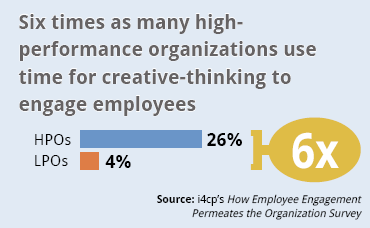Does your company allow you to block off time in your work day for creativity—a time devoted to ideation, and not connected to a project that is currently in the works? (Hint: if you have no idea what I’m talking about, the answer is “no.”)
It’s a fairly unique concept, this notion of employees outside of traditional creative roles such as industrial designers and the marketing department being encouraged to blue-sky on potential new projects. But that is exactly what is happening at forward-think companies such as 3M and Qualcomm. And, building in time for unstructured creative thinking is a practice that sets high-performing companies apart from their competition.
 According to the Institute for Corporate Productivity, “encouraging employees to block off time to develop ideas that aren’t part of their required deliverables” is one of six talent development practices that boost employee engagement.
According to the Institute for Corporate Productivity, “encouraging employees to block off time to develop ideas that aren’t part of their required deliverables” is one of six talent development practices that boost employee engagement.
What would you do if you had the time to think creatively about your job? Here are some resources to help you get started:
1. Read David Burkus’ book The Myths of Creativity: The Truth About How Innovative Companies and People Generate Great Ideas. Burkus examines common myths that tend to hold people back from realizing their creative potential.
2. When I was a corporate trainer, I used Roger Van Oech’s Creative Whack Pack cards as thought-starters for planning meetings and sessions on creativity. You can do the same for your own personal brainstorming session.
3. Speaking of brainstorming, get an excellent overview, plus some additional research links on brainstorming from Stanford University’s Bob Sutton here. Bob takes on research that was highly touted a few years ago that claimed “group brainstorming doesn’t work.”
Finally, here are some of my favorite ideas for conducting a personal creativity session:
4. Go someplace that helps you feel creative. (Yeah, I know, sadly, work may be the last place that encourages your creativity. Do what you can.) Find a conference room with a nice view of the outdoors. It might help you to stand or walk around as you think of ideas.
5. If you can swing it and the weather is nice, go outdoors. I personally find fresh air to be helpful in getting the creative juices flowing.
6. Draw. Your brain thinks differently. If you’re familiar with Mind-Mapping, try that process. Here’s a good book to get you started: Mind Mapping For Dummies.
7. Brainstorm using sticky notes. This is my favorite way to get started with ideas. I ask myself a question, then jot down each idea on a separate sticky note. Then, after I have a pile of sticky notes, I organize them into categories to see if any themes emerge. Possible questions to get yourself started:
- What’s the most audacious statement I can make about “X?” (“X” = topic you are thinking about.)
- If there were no barriers, what would I do?
- If I make a list of all the possibilities, this is what would be on the list . . .
- Which of my ideas feels like it holds the most opportunity?
- Which of these ideas gives me energy?
One last tip: even if your company doesn’t “allow” you to do this, do it anyway. Schedule a meeting with yourself, go into a conference room and get going. You’ll be amazed at how taking this time for your own personal growth will help you feel more connected to your work. And, your employer reaps benefits too: you may just come up with an amazing new product or system that launches something important.
Want more? You can see my summary of all six practices in my HR Answers.com article Retain Top Employees with These Six Talent Development Practices.
Disclosure: some of the links in this post are affiliate links, which means if you click on the link and make a purchase (browsing is free), I may be compensated. Please know that Ionly feature information and products that I believe will be of value to you.
It’s the dichotomy of the modern workplace isn’t it? Most proclaim innovation to be important to them, yet provide employees no time to do so, and no incentive (via what they measure or reward) for actually helping colleagues.
Adi,
Welcome to The People Equation!
Thanks for your wise observation -it is truly a dichotomy. Thankfully, at least some organizations are seeing the benefits of opening up time for creativity.